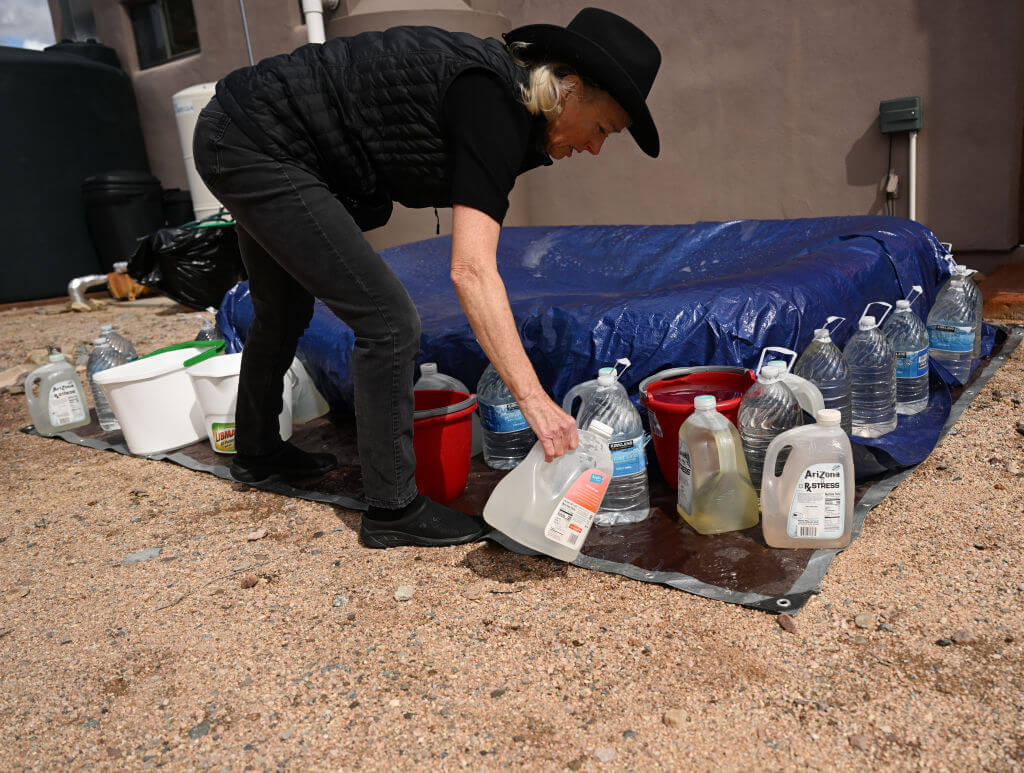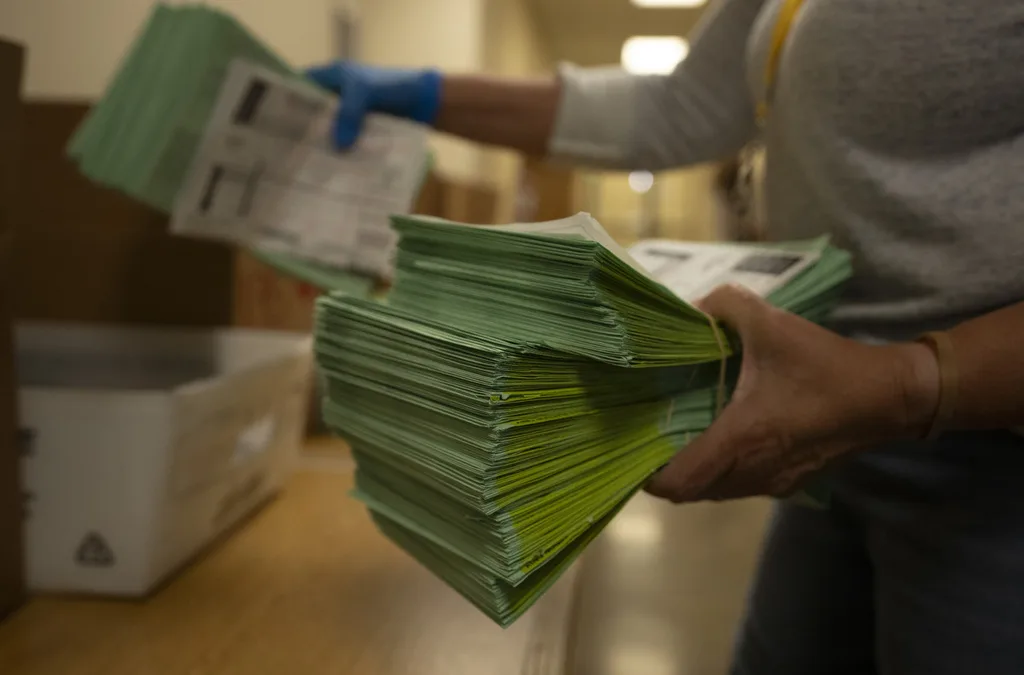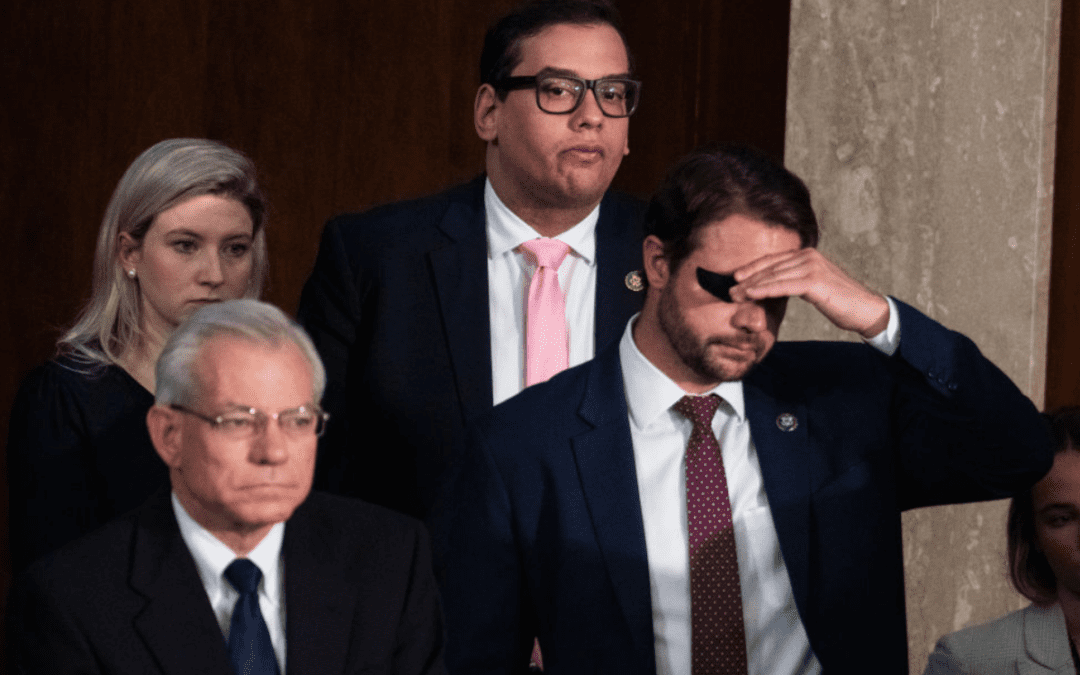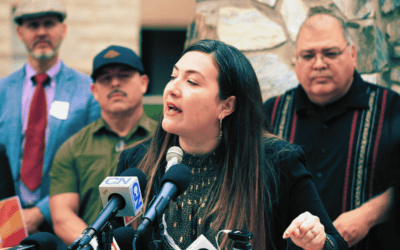
RIO VERDE, ARIZONA - FEBRUARY 26: Leigh Harris filled jugs with rain water she captured outside her home on February 26, 2023 near Scottsdale, Arizona. Harris lives in Rio Verde Foothills an unincorporated development in Maricopa County. When the Department of the Interior issued its first-ever formal water-shortage declaration for the Colorado River the City of Scottsdale stopped allowing Rio Verde Foothills to use the citys water. Harris put in a $14,000 system to catches rain water at her home. On top of that system she also puts out buckets and a kids pool to capture rain water. She and her husband primarily use the water to flush the toilets. Each gallon is one flush, said Harris. (Photo by RJ Sangosti/MediaNews Group/The Denver Post via Getty Images)
Foothills residents lost access to the city of Scottsdale’s water supply on Jan. 1 due to water shortage issues at the Colorado River. They still don’t have water.
It’s been three months since residents of Rio Verde Foothills had their water supply cut off, forcing them to find other means to receive water. As residents struggle to live on a limited water supply, conversations between municipalities continue to hold back progress.
In October 2021, individuals were notified that starting Jan. 1, nonresidents of the city of Scottsdale would no longer be allowed to utilize the city’s water supply. The change was estimated to impact about 1,000 Rio Verde Foothills residents, according to The Arizona Republic, who have relied on Scottsdale’s hauled water supply for years.
The decision came after Scottsdale’s water resources were reduced after the Tier 1—now Tier 2—drought of the Colorado River was announced. While the arrangement between Scottsdale and Rio Verde Foothills had worked for both parties for years, the worsening drought compelled Scottsdale to focus solely on the residents of their city.
Outside City Limits
The Rio Verde Foothills is an unincorporated community and doesn’t have a city council or representatives; instead, the Maricopa County Board of Supervisors (MCBS) serves as the community’s immediate government body. All decisions that involve the region have to go through the Board of Supervisors.
The area is represented by Maricopa County Supervisor Thomas Galvin, who was appointed to the position in late 2021—long after this process began. Conversations and warnings surrounding the cut off have been occurring for nearly decade and elected officials were notified in May 2020.
RELATED: Report Shows Phoenix’s West Valley Doesn’t Have Enough Water for 100-year Supply
In addition to making sure the people in Foothills residences have enough water, many residents own animals and livestock, such as horses, which require a significant amount of additional water in order to maintain. And as summer approaches, even more water will be required.
A solution is desperately needed before summer starts, yet conflict surrounding the issue seems to be at a standstill. And despite conversations taking place years in advance of the cut off, no short-term immediate solution is available and in place.
The city of Scottsdale, the Maricopa County Board of Supervisors, and even some Foothills residents have proposed their own solution—but all come with additional conflict.
An Uncomfortable Situation for Foothills Residents
Annie Hodgkins, a Foothills resident who relies on hauled water, has been forced to greatly conserve water, as the price has increased dramatically since the cutoff. She takes strict five-minute showers and didn’t keep up her garden this year.
“I have a tank and I buy water,” Hodgkins said. “If you must have it, you figure out how to afford it.”
Foothills Area residents receive water through water haulers or wells on their property.
RELATED: Supreme Court Hears Navajo Water Rights Case With Potentially Big Impact
As haulers can not pick up from the city of Scottsdale, they now have to travel much further for water. For some, the most convenient option is a 100-mile round trip drive from Apache Junction to the Foothills.
Due to the additional distance, fuel costs increase, which increases the cost of water hauled back to the Foothills.
Hodgkins’ hauler and friend, John Hornewer, used to be able to haul eight or nine loads per day. Now, due to the additional distance, he can now only do two loads a day.
‘Never in Our Wildest Dreams’
Another Foothills resident, Leigh Harris, describes living in her home like “camping” as she has been finding creative ways to receive and conserve water.
Back in the summer of 2020, Harris and her husband set up several water tanks on their property to capture rainwater from monsoons. That’s water they now rely on, as the cutoff has forced the couple to use the collected water for a number of household necessities.
“Never in our wildest dreams did we think that we would have to use that water one day for potable water,” Harris said. “But, we are now in a position of thinking seriously about that.”
In addition, the couple only flushes their toilets once a day, uses single-use plastic dishes, and relies on friends in other municipalities for drinking water—and sometimes showers—all in an effort to conserve water.
Even with these efforts, the cost of water has been a tremendous financial burden. Harris and her husband are now spending their retirement years forced to go back to work, with each of them working two jobs in order to pay for their A/C and water costs.
Harris’ children and grandchildren, who live in Tucson, have had to cut back on their visits to her home to lessen the financial burden of having additional people in the home.
“It’s much more dire,” Harris said. “They don’t want to put stress on our system.”
As of now, Harris is paying around $440 every five to six weeks to fill up her tank. Before the Jan. 1 cutoff, she paid $138 for the same service—making the current cost around a 219% increase.
While the water costs in Scottsdale vary based on usage and meter size, the average Scottsdale residents’ water costs range from around $15 to $36 per month. However, they can reach up to $270 if usage is high.
Here’s how Rio Verde Foothills residents water costs would look with each proposed solution:
The city of Scottsdale’s plan:
The plan: City of Scottsdale’s short-term temporary solution. Under their proposal, their previous arrangement with Foothills residents would continue, but Maricopa County would pay Scottsdale a base rate of $1,000 per month, plus $21.25 per 1,000 gallons of water.
The cost: $129.50 to $320.75 on average per household each month, based on water usage estimates from the Arizona Municipal Water Users Association.
The timeline: Can be implemented immediately, but city only commits to 2-3 years.
Status: Rejected by MCBS.
What residents are saying: Harris is in favor of Scottsdale’s plan in order to get the people of the Rio Verde Foothills water now.
The Maricopa County Board of Supervisors’ plans:
The plan: MCBS short-term solution: Have the private utilities company EPCOR flow water through Scottsdale’s standpipe. This would allow water to be delivered to the Foothills as it was previously, but without using Scottsdale’s water supply.
The cost: Unknown—there has been no specific proposal or setting of rates.
The timeline: Could be implemented immediately, but MCBS would need to have Scottsdale agree to allow EPCOR to use their standpipe.
Status: Standstill–Scottsdale has made it clear that they wish to have a clean break from the issue.
What residents are saying: Hodgkins believes the county is responsible for solving these issues as Scottsdale has “no obligation to us” as Foothills residents don’t pay city taxes.
“They (the Maricopa County Board of Supervisors) are trying to force Scottsdale to do their bidding, but Scottsdale has been upfront and honest about the cutoff,” Hodgkins said.
The plan: MCBS long-term solution: Work with EPCOR to build a standpipe for Rio Verde Foothills residents.
The cost: $80 million investment in infrastructure. EPCOR’s application to the Arizona Corporation Commission is $20 per 1,000 gallons, which is around $120 to $300 on average per household, based on water usage estimates from the Arizona Municipal Water Users Association.
The timeline: Two years to complete the pipeline, which will be a sustainable long-term solution after construction.
Status: Waiting on approval from the Arizona Corporation Commission to begin construction.
What residents are saying: Hodgkins and Harris are both wary of EPCOR due to its previous work in Bullhead City, which ended badly. In September 2021, Bullhead City took possession of the area’s local water system from EPCOR due to rising rates and concern over a foreign company running a local water system.
The takeover cost Bullhead City $80 million to purchase the water system from the company, which Harris called “rather unfair.”
Rio Verde Foothills residents’ plan:
The plan: Rio Verde Foothills residents would create a domestic water delivery system (DWID), which would create a water district under the community’s control. Under this plan, Foothills residents would have the authority to negotiate for water independently.
The cost: Unknown—would be up to Foothills residents in the DWID in terms of what they negotiate.
The timeline: Short-term, would have to be approved by MCBS.
Status: Rejected by MCBS in August 2022.
What residents are saying: “I had believed that our best bet was to be able to secure a piece of property that would allow us groundwater rights,” Harris said. And Hodgkins, who worked to secure around 550 signatures, wants to try to get MCBS to approve the district again.
Many members of the Rio Verde Foothills community are against the creation of the DWID.
A petition, which was created two years ago, was signed by 1,365 people against the creation of the DWID. However, the petition stated there was no immediate threat to the Rio Verde Foothills’ water supply.
Looking for the latest Arizona news? Sign up for our FREE daily newsletter.

He said what? 10 things to know about RFK Jr.
The Kennedy family has long been considered “Democratic royalty.” But Robert F. Kennedy, Jr.—son of Robert F. Kennedy, who was assassinated while...

Here’s everything you need to know about this month’s Mercury retrograde
Does everything in your life feel a little more chaotic than usual? Or do you feel like misunderstandings are cropping up more frequently than they...

Arizona expects to be back at the center of election attacks. Its officials are going on offense
Republican Richer and Democrat Fontes are taking more aggressive steps than ever to rebuild trust with voters, knock down disinformation, and...

George Santos’ former treasurer running attack ads in Arizona with Dem-sounding PAC name
An unregistered, Republican-run political action committee from Texas with a deceptively Democratic name and ties to disgraced US Rep. George Santos...




